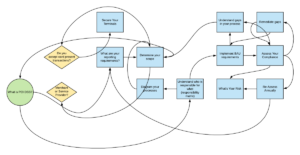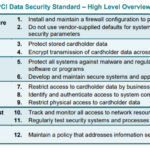In the complex world of cybersecurity, adhering to standards such as the Payment Card Industry Data Security Standard (PCI-DSS) is crucial for any business that deals with card payments. The article, “Guidelines: How a Business Can Prepare for a PCI-DSS Audit” provides a comprehensive guide on the matter. It equips you with essential tips and strategies that your organization needs to successfully navigate through the potentially overwhelming process of a PCI-DSS audit. Following these guidelines can help you ensure your business not only meets but surpasses regulatory requirements, thereby safeguarding your clients’ data while concurrently fostering a relationship of trust with them.
Understanding PCI-DSS
The Payment Card Industry Data Security Standard (PCI-DSS) is a universally recognized set of policies and procedures designed to optimize the security of credit, debit, and cash card transactions and protect cardholders against misuse of their personal information. PCI-DSS sets the standard for safeguarding sensitive payment card information, particularly cardholder data.
Exploring the purpose of PCI-DSS
The primary purpose of PCI-DSS is to ensure that all entities involved in handling payment card data manage and operate under stringent security measures. This regulatory compliance standard not only protects the cardholder’s personal data from being stolen and misused but also preserves the reputation and integrity of the businesses involved in processing these sensitive data.
Identifying who needs to comply with PCI-DSS
Any organization that stores, process, or transmits payment cardholder data, regardless of their business size or the number of transactions they carry out, must comply with PCI-DSS.
Understanding the four levels of PCI compliance
There are four levels of PCI compliance that depend on the volume of transactions a business processes per year. Level 1 includes businesses that process over 6 million transactions annually, while Level 4 includes those that facilitate fewer than 20,000 transactions annually. Each level has its own compliance requirements, with Level 1 having the most rigorous.
Studying the 12 requirements of PCI-DSS and how they apply to your business
The 12 requirements of PCI-DSS span across six control objectives, focusing on building and maintaining a secure network, protecting cardholder data, maintaining a vulnerability management program, implementing strong access control measures, maintaining an information security policy, and rigorously monitoring and testing networks. These requirements, when applied conscientiously, ensure that your business has the necessary security measures in place to handle cardholder data securely.
Assessing Business Operations
An understanding of your business operations is crucial to ensure PCI-DSS compliance. It helps ensure that the handling of cardholder data is carried out using relevant regulations.
Determining if your current operations affect PCI-DSS compliance
You must assess if your current operations fall within the scope of PCI-DSS compliance. This includes examining the systems and processes you use to store, process, and transmit cardholder data.
Understanding how you handle cardholder data
You need to have a clear vision of how cardholder data flows through your business. This includes identifying where the data is stored, who has access to it, and how it is protected at all stages of processing.
Identifying any gaps in your operations that could lead to non-compliance
Regular assessment is key to discovering gaps in your operations that could expose cardholder data to possible breaches. Identifying these gaps and addressing them promptly ensures your organization stays PCI-DSS compliant.
Exploring potential risks to cardholder data and how to mitigate them
Understanding potential risks to cardholder data allows you to develop strong and effective mitigation strategies. This includes employing robust data encryption, secure password protocols, and other protective measures.
Prepping Your Team for Audit
Ensuring your team is prepared for a PCI-DSS audit is crucial to achieving compliance. Understanding the standards, knowing the scope of the audit, and establishing a response plan are just a few preparation measures.
Communicating the importance of compliance to all team members
A team-wide understanding of the importance of PCI-DSS compliance is a strong foundation for a successful audit. This can be achieved through ongoing communication and training about the implications and benefits of compliance.
Training your team to understand PCI-DSS requirements
Regular training helps ensure your team adequately understands the requirements of the PCI-DSS. It also allows them to be familiar with their roles and responsibilities, which assists the smooth implementation of the requirements throughout the organization.
Prepping your IT team or provider for the technical aspects of the audit
Your IT team or provider plays a critical role in preparing for the technical aspects of the audit. Ensure they understand the audit process, the specific controls, and requirements to ensure a smooth process.
Developing a response plan for potential audit findings
A well-formulated response plan provides a clear direction of action if any potential non-compliance issues are discovered during the audit. This includes steps for addressing the issues, persons responsible, and timelines.
Developing a PCI-DSS Compliance Framework
Creating a compliance framework is a strategic approach to achieve and maintain PCI-DSS compliance. The framework should cover all 12 requirements of the PCI-DSS and integrate seamlessly into your overall business operations.
Building a framework that covers all 12 PCI-DSS requirements
A comprehensive framework should address every requirement of the PCI-DSS, detailing how each will be achieved and maintained. This aids in the efficient management of the compliance process.
Ensuring your framework helps maintain continuous compliance
PCI-DSS compliance is not a one-time activity. Make sure your framework incorporates a way to maintain continuous compliance, including regular evaluation and updates.
Integrating your framework into your overall business operations
For the seamless application of the compliance framework, it must be integrated into the overall business operations. This assures the principles of PCI-DSS are reflected in everyday business processes.
Revising and updating your framework as required
The dynamic nature of the data security landscape necessitates regular revisions and updates to the PCI-DSS framework. This ensures the framework is always up to date with changing security measures and threats.
Managing Cardholder Data
Efficient management of cardholder data is fundamental to PCI-DSS compliance. It doesn’t just involve safe storage but also covers secure processing and transmission of data and responsive action to possible breaches.
Understanding the importance of secure data handling
Secure handling of cardholder data protects the customers’ sensitive information from being stolen and misused. It also ensures you stay legally compliant and helps maintain trust with your customers.
Implementing secure payment systems and processes
PCI-DSS calls for secure payment systems and processes. This includes implementing secure network transmissions, encrypting stored cardholder data, utilizing secure systems and applications, and regular testing of security systems.
Applying encryption and other security measures where necessary
Encryption is a key measure in the protection of cardholder data. Other security measures include the use of firewalls and anti-malware installations, regular security updates, and implementing strong access control measures.
Responding to potential data breaches quickly and effectively
A swift and effective response to data breaches can significantly limit damage. This requires a well-prepared incident response plan detailing necessary steps, roles, and communication lines in case of a data breach.
Implementing Security Measures
Ensuring continuous security forms the foundation of the PCI-DSS. This involves various measures ranging from network security to control measures and third-party vendor management.
Ensuring secure network and systems
Strong security measures, including firewalls and antivirus software, are essential in establishing secure networks and systems. Regular updating and patching of these security measures also play a role in maintaining the health of your systems.
Regularly testing and updating security systems
Regular security system tests ensure that defenses are robust and effective. Updates to security features are an important facet of maintaining ongoing security as they protect against new and evolving threats.
Developing policies that apply to vendors and third-party service providers
Vendors and third-party service providers should also be required to adhere to your company’s data security policies. By broadening the scope of compliance, risk is minimized.
Implementing strong access control measures
Access control measures are an integral part of the PCI-DSS. These prevent unauthorized individuals from accessing cardholder data and help maintain the principle of least privilege.
Engaging with a Qualified Security Assessor (QSA)
A Qualified Security Assessor (QSA) is a crucial partner in attaining PCI-DSS compliance. Choosing the right QSA, understanding their role, and actively collaborating with them throughout the audit process are key for a successful audit.
Choosing a suitable QSA for your business
Selecting a QSA who is well-suited to your business can help simplify the compliance process. The QSA should have a deep understanding of your business operations and the requisite experience to handle the scope and complexity of the task.
Understanding the role of a QSA
QSAs are trained and certified by the PCI-Security Standards Council to perform PCI-DSS assessments. Their role includes examining your organization’s compliance with the requirements, identifying any shortcomings, and providing remediation guidance.
Working closely with your QSA throughout the audit process
Actively collaborating with your QSA throughout the audit process allows for a smooth audit. Open communication ensures that all audit expectations and requirements are clearly defined and understood.
Addressing audit findings and recommendations from your QSA
Addressing audit findings promptly and implementing recommendations from your QSA enables swift corrective action. This not only helps in achieving compliance but can also improve overall security and business operations.
Documenting Policies and Procedures
Comprehensive documentation is an essential part of PCI-DSS compliance. It helps provide evidence of compliance and acts as a reference point for your policies and procedures.
Drafting comprehensive policies and procedures for PCI-DSS
Policies and procedures should clearly articulate how your business meets each of the PCI-DSS requirements. This includes details on management’s role, handling of cardholder data, incident response, and training, among others.
Keeping policies and procedures up to date
Regular updating of policies and procedures keeps them relevant to current operational scenarios and evolving security risks. It also shows the commitment to continual compliance.
Identifying individuals responsible for maintaining PCI-DSS documentation
Assigning specific individuals or teams to maintain PCI-DSS documents helps foster accountability. It ensures that the documentation is always up to date and that audits are facilitated smoothly.
Presenting documentation during the audit process
During the audit process, all compliance documents should be readily available. Also, the staff should have a solid understanding of where the documentation is located and what information it contains.
Ongoing Maintenance and Compliance
PCI-DSS compliance is not a one-time affair. Ensuring continuous compliance includes conducting regular review and updates, preparing for business changes, and taking corrective actions when necessary.
Importance of regular compliance checks
Regular checks ensure that the business continues to adhere to the compliance requirements, allowing for the early detection of possible issues and limiting the possibility of non-compliance.
Periodically reviewing and updating PCI-DSS security policies
Security threats and vulnerabilities are continually evolving. Therefore, periodic reviews of the PCI-DSS security policies are necessary to ensure they continue to offer robust protection against cardholder data breach.
Ensuring compliance during business changes or updates
Changes in business operations may impact compliance status. Regular assessments can ensure that any business changes or updates adhere to the PCI-DSS, maintaining continuous compliance.
Taking corrective actions when non-compliance issues are identified
In case of any identified non-compliance issues, immediate corrective action is necessary. This includes documenting the issue, identifying the root cause, taking corrective action, and reassessing to ensure the problem has been appropriately resolved.
Conducting Self-Assessments
Self-Assessments can be a proactive way of affirming your compliance status by offering an opportunity to detect and correct any issues before an external audit is conducted.
Importance of periodic PCI-DSS self-assessments
Performing regular self-assessments can offer valuable insights into your security status. It provides a chance to detect and correct non-compliance issues before facing an external audit.
Understanding how to perform a self-assessment
Performing a self-assessment typically involves following the guidelines provided in the Self-Assessment Questionnaire (SAQ) provided by PCI-DSS. This includes reviewing your compliance status against each requirement, documenting the findings and taking necessary steps to address any discovered deficiencies.
Using self-assessment findings to prepare for the audit
The findings from your self-assessment can help immensely in your audit preparation. By addressing the discovered deficiencies in advance, you minimize the chances of non-compliance during the official audit.
Correcting any issues found during self-assessments immediately
Taking swift corrective action on any issues discovered during self-assessments ensures that you are on the right track towards compliance. It provides reassurance that you are taking steps to maintain the required security standards.
Remember, preparing for a PCI-DSS Audit isn’t an exercise merely to comply with a standard; it’s a key step to ensuring that your business is secure and trusted by your customers. A well-planned and prepared PCI-DSS Audit can help you establish sturdy defences to protect cardholder data, making your business a secure place for transactions.











